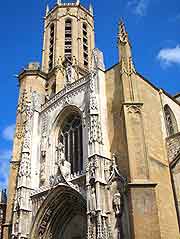Aix en Provence History Facts and Timeline
(Aix en Provence, Provence-Alpes-Cote d'Azur, France)

Archaeological excavations have revealed that the history of Aix en Provence began in 123 BC, when it was founded by the Romans. They named the town Aquae Sextiae in honour of the Roman ambassador Sextius Calvinus.
The Romans quickly discovered the benefits of the town's hot springs and developed it into an urban centre and spa. In 102 BC, the town was the scene of a great battle. Under the leadership of Gaius Marius, the Romans defeated the Germanic tribes of the Cimbri and Teutones.
In the 5th century, with the withdrawal of Roman forces, Aix en Provence was conquered by the Visigoths. In the years that followed, the town came under attack from various groups, including the Franks and the Lombards. It's at this point in the town's history that work started on the building of a cathedral. The site chosen for Cathédrale St. Sauveur was considered to be sacred. Indeed, the Romans are said to have built a temple here. In 731 AD, Aix en Provence was captured by the Saracens and a period of relative peace followed. The town began to prosper again.
From the Middle Ages
By the end of the 12th century, the town had become much more politically stable. In 1182, Aix en Provence was ruled by the counts of Provence. New convents were built here, including the one belonging to the Knights of Saint Jean de Malte.
In 1409, Louis II of Anjou founded a university here, and in 1487, Aix en Provence passed into French hands and began to grow in earnest. During the remainder of the 15th century, under King René, the town became a centre for administration and culture. This was something of a 'golden age' for the town. Although part of the Kingdom of France, Aix en Provence refused to accept French central policies.
During the reign of Louis XIV, Aix en Provence became a 'courtesan' town. History shows that from the mid-17th century, everyone wanted to settle here, including aristocrats, magistrates and religious communities. The town's crumbling walls were replaced by a street that was better suited to cope with busy traffic - it was to become the Cours Mirabeau. Aix en Provence became a place where you'd expect to find fine mansions with impressive gates. The town's visitors included scholars and artists.
Modern Times in the City
In 1839, the artist Paul Cézanne was born here. He studied art at the municipal school of drawing, which is now the Granet Museum. Cézanne was to share his life between his home town of Aix en Provence and
Paris. The novelist Émile Zola, a contemporary of Cézanne, spent a great deal of time here during his childhood.
When World War Two ended, the town of Aix en Provence was again revived. A new university was built in the south and by 1959, the town had a population of around 70,000. In the 1960s, many immigrants came here, mainly from North Africa.
In the mid-1990s, the Front National political party led by Jean Marie Le Pen gained many supporters in Provence, winning the municipal elections here. Mass protests took place and the party was eventually defeated. Today, Aix en Provence is a busy university town and popular tourist destination.
 Archaeological excavations have revealed that the history of Aix en Provence began in 123 BC, when it was founded by the Romans. They named the town Aquae Sextiae in honour of the Roman ambassador Sextius Calvinus.
Archaeological excavations have revealed that the history of Aix en Provence began in 123 BC, when it was founded by the Romans. They named the town Aquae Sextiae in honour of the Roman ambassador Sextius Calvinus.